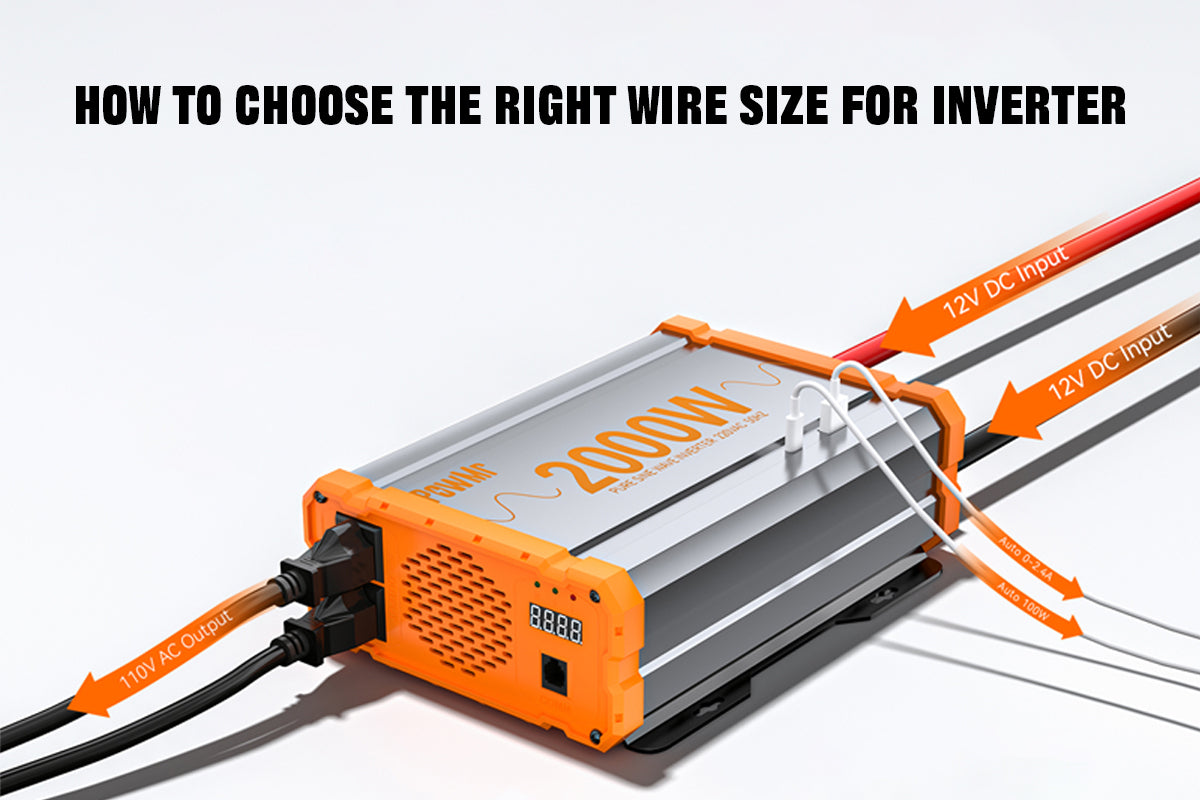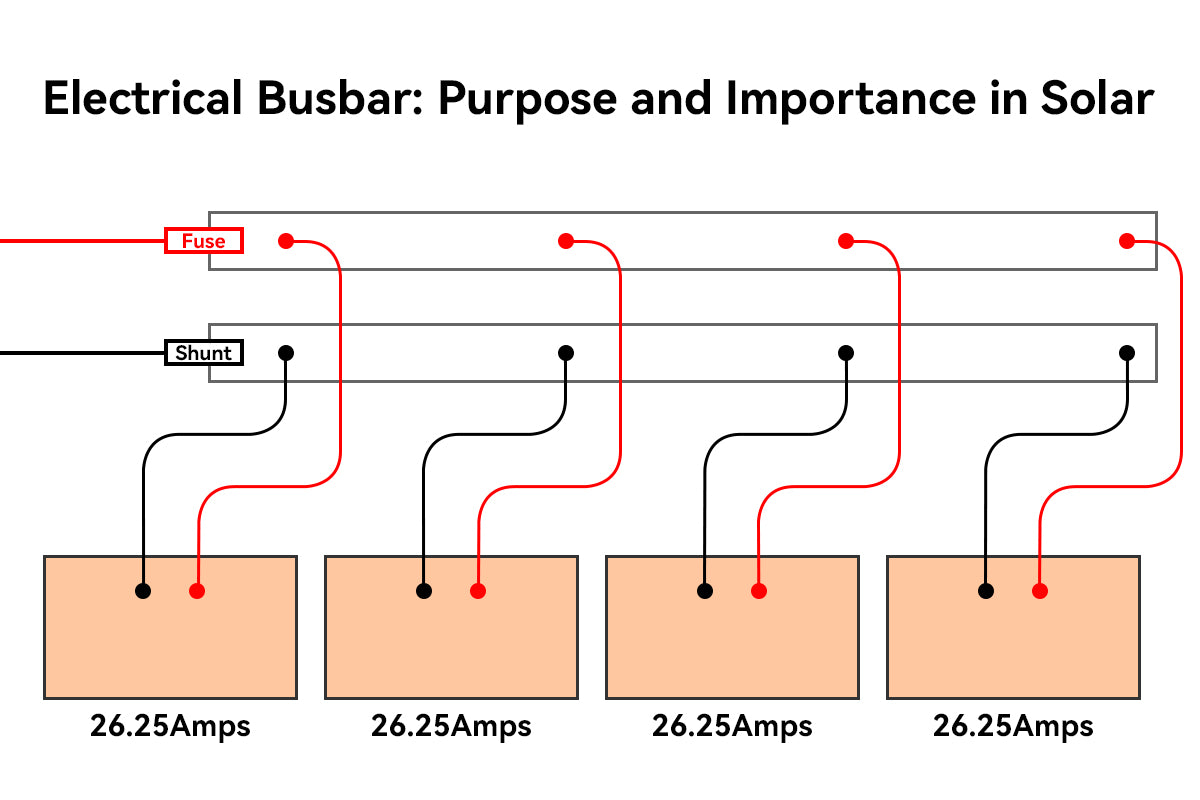Choosing the correct inverter wire size is essential for the safety, performance, and code compliance of a solar power system, whether you're installing an off-grid inverter or setting up an inverter for a home backup system.
Using the wrong inverter cable size can lead to serious consequences such as overheating, inverter shutdown or damage, and even fire.
In this guide, we’ll walk you through how to size wires for inverter connections using a 2000W inverter as an example and provide a wire size chart for common inverter sizes (1200W–3000W).
How to determine inverter wire size
Inverters convert DC power from your batteries or solar panels into usable AC electricity. So, the wire for the inverter connection two parts connecting the inverter to your battery bank (DC side) or to your distribution panel (AC side). Each side operates at a different voltage and current level, so the wire sizing requirements are different.
Note: Always follow the manufacturer’s recommendation when available. If not provided, wire size should be selected based on NEC Section 690.8(B), which specifies that conductor ampacity must be at least 125% of the inverter’s maximum continuous output current. This factor may vary depending on your country or local regulations. If no specific rule applies, a 1:1 ratio is advisable.
DC wire size for inverter
As introduced in our battery cable size guide, sizing the cable between the battery and inverter requires calculating the DC current the inverter will draw under load.
Since the inverter pulls power directly from the battery at DC voltage, the current depends on the inverter’s rated power, efficiency, and battery voltage. To ensure safe operation, NEC guidelines recommend sizing the wire for 125% of the calculated current.
Cable Ampacity ≥ Inverter Power (W) ÷ Inverter Efficiency (%) ÷ Battery Voltage × 1.25
AC wire size for inverter
To power your appliances or distribution panel, the inverter converts DC electricity into AC, typically at 110V or 220V, depending on your region and grid requirements. Compared to the DC side, the current on the AC output side is significantly lower due to the higher voltage.
The wire sizing method is similar, but it uses the AC output voltage in the calculation.
Inverter wire ampacity ≥ inverter power ÷ Efficiency (%) ÷ AC Output Voltage × 1.25
Once you know the current the wire must carry, select the appropriate wire size based on distance using an AWG wire size and ampacity chart. Always round up and choose a larger wire size for longer runs to minimize voltage drop.
What size wire for 2000w inverter
Let’s take a 2000W inverter as an example. With an efficiency of 90%, it actually draws about 2220W of power.
On the DC side, assuming the 2000w inverter is connected to a 12v battery, typically requires 4/0AWG wire for short run, which needs to handle over 230amp applying the sfety margin(2220w/12v*1.25). For longer distances, even thicker cables or parallel wiring may be necessary to control voltage drop.
On the AC side, if the 2000W inverter outputs 110volt, 10 AWG wire is usually sufficient to handle the 25-amp current (2222W ÷ 110V × 1.25). If the output is 220V, 12 AWG wire is generally adequate to carry the approximately 13-amp current drawn by the inverter over a distance of around 7 to 10 feet.
Note:
These are general examples. Always refer to the manufacturer’s manual, and adjust wire size based on actual run length, ambient temperature, and installation method to ensure safe and efficient operation.
Inverter cable size chart
The following charts provide general wire size recommendations for both DC and AC sides based on common inverter sizes. These estimates assume 90% inverter efficiency, short cable runs, and copper wire.
DC Side
| Cable Length (ft, round-trip) | 12V 1200W | 12V 2000W | 24V 3000W |
|---|---|---|---|
| 5 | 1/0 AWG | 3/0 AWG | 2/0 AWG |
| 10 | 1/0 AWG | 4/0 AWG | 2/0 AWG |
| 15 | 1/0 AWG / 4/0 AWG | 4/0 AWG | 2/0 AWG |
AC Side
| 110 Volt Output | |||
|---|---|---|---|
| Cable Length (ft, round-trip) | 1200W | 2000W | 3000W |
| 5 | 12 AWG | 10 AWG | 8 AWG |
| 10 | 12 AWG | 10 AWG | 8 AWG |
| 15 | 10 AWG | 8 AWG | 6 AWG |
| 220 Volt Output | |||
| Cable Length (ft, round-trip) | 1200W | 2000W | 3000W |
| 5 | 16 AWG | 14 AWG | 12 AWG |
| 10 | 14 AWG | 12 AWG | 12 AWG |
| 15 | 12 AWG | 10 AWG | 10 AWG |
Notes:
- Round-trip length means the total length of the cable from inverter to battery/load and back.
- For very long cable runs, consider voltage drop carefully and size wires larger.
- Parallel cables may be necessary for very high current DC applications.
- Always comply with local codes and manufacturer recommendations.


